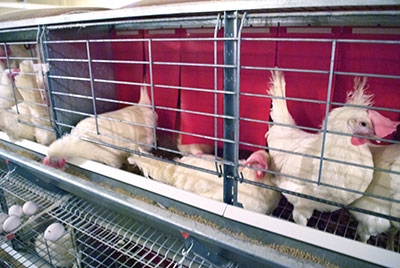
Laying Behaviour
By Karen Dallimore
Features Housing Research Poultry Production ProductionInvestigating how hens perform nesting behaviour in furnished cages
 Rearing experience influences the nesting behaviour of laying hens and their ability to settle more quickly into a new environment
Rearing experience influences the nesting behaviour of laying hens and their ability to settle more quickly into a new environment
An attractive nest site is one of the reasons for using furnished cages for laying hens, but what does the hen consider attractive?
To help answer that question, Michelle Hunniford, a PhD student at the University of Guelph, is investigating how hens perform nesting behaviour in furnished cages at the Arkell Research Station in
Guelph, Ontario.
Two of her most recent studies have compared some of the variables, such as group size and space allowance, as well as a hen’s previous rearing experience, to see what affects nesting behaviour in furnished cages.
In her first experiment, Hunniford used Lohmann LSL-lite hens to examine the impact of cage size and space allowance. The hens were divided into 12 large commercial and 12 small custom-built Farmer Automatic furnished cages, each fitted with a nest area (large nest: 5,664 cm2; small nest: 2,816 cm2) with red plastic curtains and a yellow plastic mesh floor, and a 42 cm2 smooth red plastic scratch mat at the opposite end of each cage.
Working under the supervision of Dr. Tina Widowski, the Egg Farmers of Canada Research Chair in Poultry Welfare, Hunniford also looked at the behaviour of birds kept at different space allowances in large and small cages, comparing low (520 cm2/bird) versus high (720 cm2/bird) space allowance in both small and large cages.
How would competition for nesting space or floor space be reflected in where they laid their eggs?
The location of lay, whether in the nest area, scratching area, or somewhere in between, was recorded between 21 to 70 weeks of age, and the time of lay was monitored for eight days at 54 weeks of age. The hens’ disposition was measured by recording the number of occurrences of displacements, aggressive pecks, threats and fights.
The results indicated that hens did respond differently to different-sized cages.
In the small cages, 91.7 per cent of hens used the nesting area compared to 77.2 per cent in the large cages. Most of the remaining eggs were laid in the scratch area. Hens in the smaller cages with low floor space allowance were more aggressive than the other groups, which Hunniford suggests may be because hens in smaller cages were more competitive for nesting space. Also, the birds in larger cages may have perceived the scratch area as an attractive alternative nest area because it was fitted with a wire partition which added more corners into the cage.
Hunniford did conclude that increasing the absolute size of a curtained nest area in a larger cage might not provide the most attractive nest site for hens.
Greater than 30 per cent of the hens in large cages laid their eggs between 8 and 9 a.m., while those in the small cages laid between 7 and 10 a.m. This difference may indicate a lack of available nest space in the small cages, causing hens to delay laying their eggs. More pecks and threats were recorded between 8 and 8:30 a.m., which coincided with peak laying time.
The number of eggs laid in a nest is often used as an indicator of how well the hen accepts the nest, but is this truly the case? Since the hens in the smaller cages were more aggressive yet laid more eggs in the nests, the results also raise questions about using the number of eggs laid in a nest as an indicator of hen welfare.
Hens that show more settled pre-laying behaviour — less walking, more time sitting at the laying site, and showing less aggression — may give a better indication of animal welfare than where they lay their eggs.
“It is not enough to record egg location and make the conclusion that high nest use correlates with good welfare. The same behaviours associated with poor welfare (i.e. aggression) were also in the cages with the highest nest use. This suggests that behaviour is a very important component that must be taken into account when assessing welfare.”
In her second experiment, Hunniford compared hens reared in standard brooding cages with those reared in a pullet-rearing aviary (Farmer Automatic Pullet Portal) to investigate the effect of rearing environment on egg-laying preferences.
Hens that were reared in standard cages preferred laying in the nest versus the scratching area (89.6 per cent versus 81.3 per cent) but showed more of what Hunniford called “unsettled pre-laying activity” — walking, searching and nest area entries — prior to week 20 of lay when compared to the aviary-raised birds. This behavioural difference had diminished by peak lay at week 32.
Hunniford concluded that rearing experience influenced the nesting behaviour of laying hens and their ability to settle more quickly into a new environment. “This result was somewhat unexpected,” says Hunniford. “It shows that we still have a lot to learn about how rearing environment impacts the behaviour and spatial awareness of adult laying hens.”
In the next phase of her research, Hunniford will investigate which nest site design is preferred by hens by testing different enclosure and surface material conditions. The overall objective of this research project is to help determine optimal design parameters to support nesting behaviour in furnished cages. Her work is supported by grants from Egg Farmers of Canada and the Ontario Ministry for Agriculture and Food.
Print this page